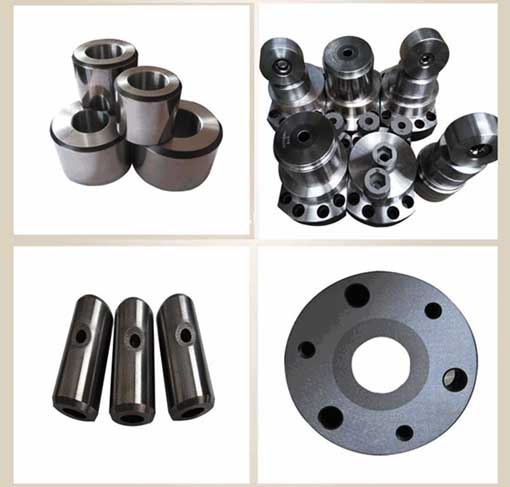Hard machining characteristics of cemented carbide parts

Typically said processing hardness exceeds 56HRC, or strength exceeds Rm> steel materials 2000N / mm2 for hard machining. In most cases, the mold or forging die is subjected to carburizing or quenching after pre-machining. After pre-machining, a certain finishing allowance must be reserved. Hard milling is especially important when machining workpieces with spherical or toroidal shapes.
Hard milling can be cut to the material hardness of 70HRC, the desired surface roughness by means of manual polishing is usually only to achieve, which is a very expensive processing step. In order to reduce the time required for manual polishing, it is necessary to utilize a cutting edge with a defined geometry during milling. For example, in HSC processing, the surface is close to the roughness of the polished surface: the surface quality of Rz1 at most.
Hard metal milling cutters that are common on the market are not suitable for cutting in this range. To solve the milling problem of hard materials, some prerequisites must be met.
For example, a milling cutter made of a special cemented carbide base material with a unique geometry and corresponding coating is used. This means that the tool must have these three important elements. Special attention must be paid to the balance between these elements during the manufacture of the tool.
It is usually possible to cut a workpiece with a hardness exceeding 56HRC by HSC processing. In this regard, the limitation is the combined effect of cutting speed and temperature. For HSC, the melting point of the workpiece material must be tested at the appropriate cutting speed. Usually the melting point of the workpiece material is higher than the highest allowable temperature of the coating, so care must be taken. The best aphorism here is "keep the tool cool." This means that on the one hand the contact area with the workpiece has to be as small as possible, and on the other hand the cutting must be carried out at a certain speed so that the cutting edge does not reach the heat exceeding the temperature allowed by the coating.
Correct detection of speed is especially important. For this purpose, it must be based on the actual effective tool diameter. In the case of the lateral feed amount ap = 0.1 mm, the ball end mill having a diameter of 6 mm has an actual effective diameter of 1.54 mm. In order to achieve a cutting speed of 200 m/min, the speed must be 41000 r/min.
The chips generated during processing and the heat carried by the chips must be removed as quickly as possible. The best method is to blow compressed air directly to the cutting edge through the spindle. Compressed air can carry a small amount of lubricant depending on the material of the workpiece. A better amount of surface quality can be produced with a small amount of lubricant because the chips do not stick to the cutting edge. For hard cutting, the emulsion must never be used. Just a drop of water can cause a sudden temperature change and break the tool into a single component. The microcracks of the cemented carbide caused by the sudden change in temperature will cause the cutting edge to crack. In the case of HSC machining, depending on the tool diameter and speed, these pieces may have the equivalent of the energy of the bullets ejected from the light weapon.
The earliest HSC milling developed for graphite cutting not only means high speed and large feed rate, but also has a wide range of applications under the combined effect of many factors. The power of hard milling is largely determined by the machine tool used. All in all, the concept of hard cutting is associated with high speed machining.





